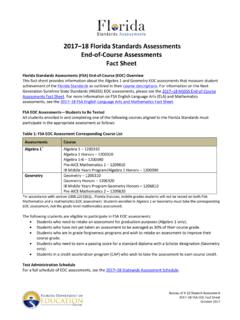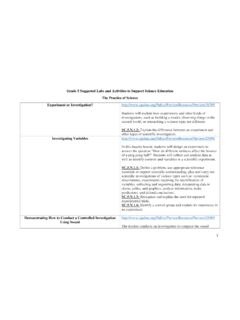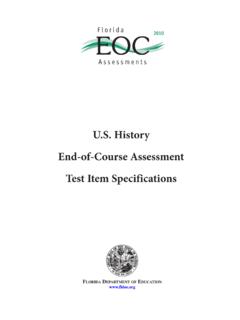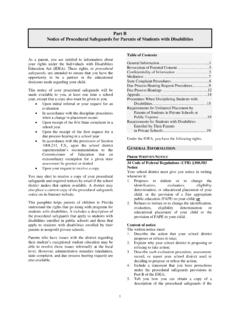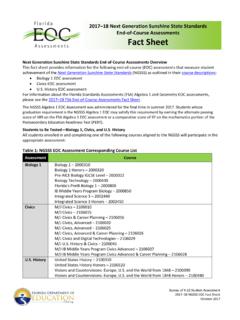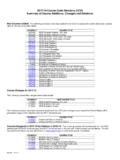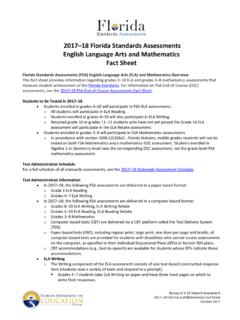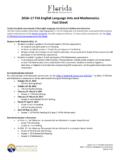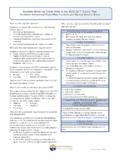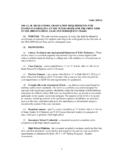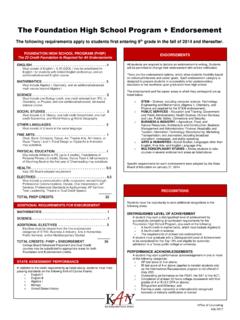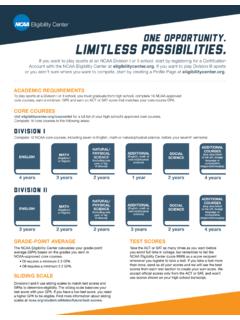Transcription of Assessment Investigation Report - fldoe.org
1 Assessment Investigation February 18, 2015. Table of Contents 1. Executive Summary 3. 2. Recommendations 4. 3. Purpose and Value of Assessments 5. 4. Assessment Definitions 6. 5. History of Florida's Statewide Assessment Program 8. 6. Impact of Florida's Education Reforms on Student Achievement 9. 7. Statewide, Standardized Assessments Requirements and Uses 12. 8. Federal Assessment Requirements 23. 9. Local Assessment Requirements 25. 10. Summary of District Information 27. 11. Appendices A. Testing Times Other Statewide Assessments B. 2014-15 Statewide Assessment Schedule C. Computer-Based Testing Transition Chart D. Elementary and Secondary Education Act Assessment Language E. Florida Statutes Language on Local Assessments F. District-Level, Standardized Assessment Summaries 2. Executive Summary In late 2014 and early 2015, Commissioner Stewart conducted a thorough and comprehensive Investigation of all standardized assessments used in school districts.
2 The first step in conducting this Investigation was to survey districts on the standardized assessments they give. In December 2014, a template was sent to each district to record the following: What district-level, standardized assessments are given What student decisions are based on test results ( , promotion, course grade, progress monitoring; includes additional district uses of statewide, standardized test results). Why students are required to take the test What grade levels or groups of students take the test Whether test information is provided to teachers, parents, and/or students How much time is given for the test on how many days How often and when the test is given In what format the test is given (computer, paper, or other). Information was returned in January 2015 to assist the commissioner in completing the Investigation and this Report , including district-level, standardized assessments that may be summative or interim in nature, and used for benchmarking or progress monitoring.
3 Neither formative assessments nor teacher- developed or teacher-selected assessments are included in the Report . District summaries were drafted by department staff and returned to each district for additional verification. District summaries can be found in Appendix F. To give the district information context, this Report also provides information on Florida's statewide, standardized Assessment program and the state-required use of results. This Report is organized in the following manner: 1. Recommendations 2. Purpose and Value of Assessments 3. Assessment Definitions 4. History of Florida's Statewide, Standardized Assessment Program 5. Impact of Florida's Education Reforms on Student Achievement 6. Statewide, Standardized Assessments Requirements and Uses 7. Federal Assessment Requirements 8. Local Assessment Requirements 9. Summary of District Information 10. Appendices 3. Recommendations Florida has a strong, established statewide, standardized testing program that measures student progress and provides useful information to educators and parents.
4 During the course of the commissioner's Investigation , the department identified several places where the state requirements should be reduced. In order for Florida to move forward with fewer, better assessments, the commissioner recommends enacting the following four measures: 1. Issue an Executive Order to suspend the Grade 11 Florida Standards Assessment (FSA) for English language arts until legislation is enacted to eliminate the mandate. Since students meet their English language arts graduation requirement upon completion of the grade 10 Assessment , the Grade 11 FSA for English language arts is no longer needed. 2. Enact legislation to eliminate the Postsecondary Education Readiness Test (PERT) as a state mandate for grade 11 and make it optional. The department believes that the PERT current practice should continue as an option for students in high school and local colleges. Rigorous standards and increased graduation requirements are in place to ensure college and career readiness upon high school graduation.
5 3. Enact legislation to eliminate the current progress monitoring requirements. The department believes current state requirements are overly prescriptive and progress monitoring decisions should be left at the district level. 4. Enact legislation to eliminate local final exams in courses/subjects where there is also a statewide, standardized end-of-course exam. Current statewide end-of-course assessments are Algebra 1, Algebra 2, Geometry, History, Biology 1, and Civics. Further, the commissioner urges districts to consider the following recommendations: 1. Give no more than one school-wide or district-wide interim Assessment per course/subject per grading period. Interim assessments are administered at certain times during the school year, and can be used to predict a student's ability to succeed on a summative Assessment or to diagnose student learning gaps. 2. Don't test students for the sole purpose of evaluating teachers.
6 It is important to recognize the contribution of teachers in students' learning. Students already take tests to determine whether they know their subject matter and districts should use information from these tests to help gauge teacher performance. 3. Provide teachers, parents, and students with information about how students are doing on each Assessment used to monitor student progress. Teachers, parents, and students deserve to know how well students are grasping the content they are taught. For parents, this information can be a sign that their child could benefit from additional assistance, while teachers may use the information to adapt their lessons to meet students' needs. 4. Purpose and Value of Assessment The primary purpose of Florida's K-12 Assessment system is to measure students' achievement of Florida's education standards. The Florida Standards were developed and implemented to ensure that all students graduate from high school ready for success in college, career, and life.
7 Assessment supports instruction and student learning. Assessment results help Florida's educational leadership and stakeholders determine whether the goals of the education system are being met. Assessments help Florida determine whether we have equipped our students with the knowledge and skills they need to be ready for careers and college-level coursework. Assessment allows us to answer key questions such as: "Are we teaching what we think we are teaching?". "Are students learning what they are supposed to be learning?". "Is there a better way to teach the subject, thereby promoting better learning?". Florida's educational assessments also provide the basis for student, school, and district accountability systems. Assessment results are used to determine school and district grades which give citizens a standard way to determine the quality and progress of Florida's education system. Assessment results are also used in teacher evaluations to measure how effectively teachers move student learning forward.
8 While Assessment plays a key role in Florida's education system, it is important to remember that testing is not an end in itself, but a means to an end. Florida's Assessment and accountability efforts have had a significant positive impact on student achievement over time. Some of these positive impacts are highlighted later in the Report . 5. Assessment Definitions In order to ensure a common understanding of terminology used in discussing assessments, some key terms are defined in this section. Assessment Categories For the purposes of this Investigation , K-12 student assessments fall into three broad categories: 1. Statewide, standardized assessments 2. State-required, locally determined assessments 3. District-required, locally determined assessments Definitions of these categories are provided below. Statewide, standardized assessments By statute, Florida's statewide, standardized Assessment system is composed of comprehensive assessments in English language arts in grades 3-11, comprehensive assessments in mathematics in grades 3-8, and end-of-course (EOC) assessments in Algebra 1, Geometry, Algebra 2, Biology, History, and Civics.
9 The statewide, standardized assessments also include the Florida Alternate Assessment (FAA), which measures academic achievement of students with significant cognitive disabilities. These assessments are all summative, which means that they are used to evaluate student mastery of Florida's academic standards at or near the conclusion of the course of instruction. EOC. assessments are factored into students' course grades. State-required, locally determined assessments Also by statute, districts are required to administer local assessments that measure student mastery of course content at the necessary level of rigor for the course. These summative assessments are to be provided for all subjects and grade levels not measured under the statewide, standardized Assessment program. These assessments may factor into student course grades. District-required, locally determined assessments Districts may require other assessments not explicitly called for in state statute.
10 These may be additional summative assessments, or these may be interim assessments. Interim assessments are administered at certain times during the school year, and can be used to predict a student's ability to succeed on a summative Assessment or to diagnose student learning gaps. Interim assessments can also be used in progress monitoring, which is the process used to determine whether a student's academic performance is improving, at what rate it is improving, and how effective instruction has been. These assessments may factor into student course grades. 6. Additional Assessment Definitions Testing Time vs. Testing Window . There is often confusion regarding the time that an individual student spends taking tests, as compared to the time that districts allot for all district and state testing to be completed for all students. This difference is more fully explained below. Testing Time: Testing time is the amount of time individual students are given to respond to test items on each test.
